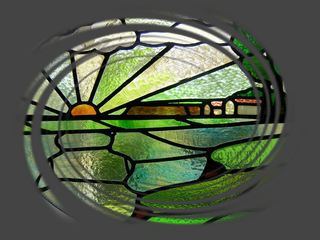 |
Dinas Silica Mines, South Wales |
 |
Dinas Silica Mines, South Wales |
That doesn't mean you should not treat them with respect both in terms of the historical aspects and the fact you are in an underground and therefore more than potentially dangerous environment
There are actually three extensive sections of known mine workings. All of these pictures are from the main Upper mine workings.
The mines have several large entrances and are easily visible from the path, but they are fenced off with suitable warnings. I've met people who are totally ill equipped in here .. don't make yourself another cave rescue statistic if you don't know what you are doing stay out !
The total area of the underground passages is estimated at over 1000m x 500m, but some cannot be visited by most as parts of the mine are now flooded.
Mining was 'pillar and stall' which means little propping is needed, but some of the pillars were obviously worked a little thin as some have secondary brickwork to strengthen them. According reports firing was at night to allow the dangerous dust to settle before the next day's work.
The rock was transported on a series of tramways and inclines and overhead cables can still be seen in the cave. When I first came to South Wales some were still suspended on pylons down the valley floor and then onward to the brick works.
When these were still standing they must have been impressive according to this quote 'Dinas Quartzite Mine', A.D. Semmens, The Industrial Railway Record, No.7, Sept 1965 pp.141; August 1963 : 'The present modu operandi is cable operation to an adit top immediately above the one which forms the mine entrance where a very small gantry leads to the aerial ropeway. The latter climbs up one side of the hill, and from there the topmost pylon carries the full strain of the drop to the bottom; the manager said it was the longest aerial ropeway span in the country.
The mines were in operation from around 1822 when they are founded by William Weston Young to 1964 as the high quality rock, almost pure silica (Basal Grit which is a pure quartzite) was excellent for making fire-bricks which were used locally and also exported across the world.
I should say that the reason I put around in bold was because I have found so many competing dates on the internet that I'm not confident in the dates. The Royal Comission website says that the process was not invented until 1827 whereas the entry in Wikipedia on William Weston Young says he started in 1822. There are also other dates out there and I've not had time for in-depth research I just advise caution on trusting what you see.
The passages have a dip of about 20 degrees and are mined in sections using pillar and stall and in some sections in straight levels. The lower levels, whilst flooded, are filled with very clear water and it is possible to see down a couple of levels at times
The mines contain some interesting cave formations
there are iron stained stalactites and "snotalite" which are bacterial
masses that hang like stalactites, but move in a gentle breeze
It is the purity of these rocks which are almost 100% silica (SiO2) that made them so sought after. i nthe 18th and 19th Centuries, the industries of industrial South Wales needed large numbers of heat-resistant bricks to line the furnaces in which copper and iron-smelting took place. Only bricks made from more or less pure silica can stand the intense temperatures without shattering.
The welsh word Dinas refers to the largest of the silica mines. So significant was the amount and quality of silica bricks exported from South Wales to the industrial revolution that the word Dinas has entered into many languages most notably Russian where it means all Fire bricks.
I have never cave Dived and therefore all of my pictures are from the none flooded sections. If you would like to read about the underwater sections and see what they look like there are some interesting articles Here and Here. There is an interesting Historical Photograph of Dinas Silica Mines Here.
These pictures were taken on a trip with the International Society for Speleological Art which we are members of and who include a number of well known artists
The pictures are taken on Olympus E-500 camera with 14-42 lens and an E-510 cameras with 11-22mm lens. The flash units are Olympus FL-36 and FL-50 units on manual settings and triggered using cactus wireless slave units